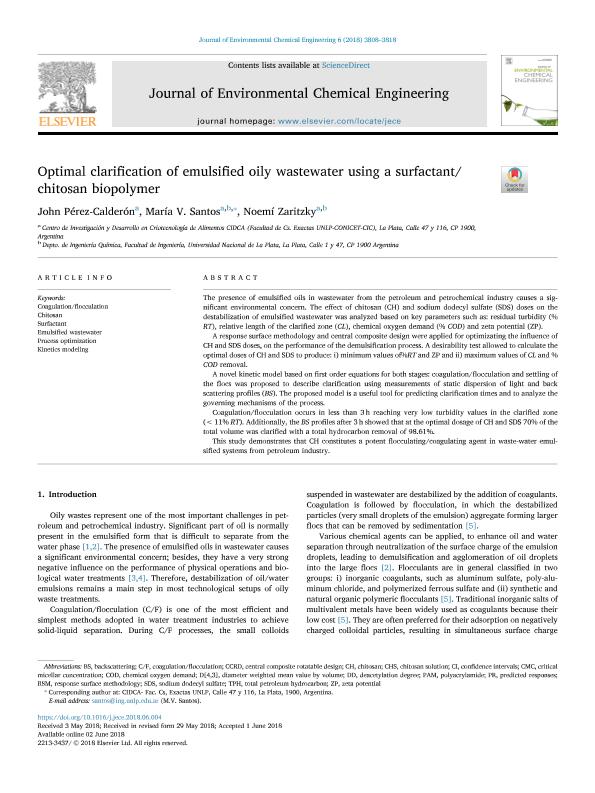Mostrar el registro sencillo del ítem
dc.contributor.author
Perez Calderon, John Freddy

dc.contributor.author
Santos, Maria Victoria

dc.contributor.author
Zaritzky, Noemi Elisabet

dc.date.available
2019-10-18T17:33:12Z
dc.date.issued
2018-08
dc.identifier.citation
Perez Calderon, John Freddy; Santos, Maria Victoria; Zaritzky, Noemi Elisabet; Optimal clarification of emulsified oily wastewater using a surfactant/chitosan biopolymer; Elsevier Ltd; Journal of Environmental Chemical Engineering; 6; 4; 8-2018; 3808-3818
dc.identifier.issn
2213-3437
dc.identifier.uri
http://hdl.handle.net/11336/86389
dc.description.abstract
The presence of emulsified oils in wastewater from the petroleum and petrochemical industry causes a significant environmental concern. The effect of chitosan (CH) and sodium dodecyl sulfate (SDS) doses on the destabilization of emulsified wastewater was analyzed based on key parameters such as: residual turbidity (% RT), relative length of the clarified zone (CL), chemical oxygen demand (% COD) and zeta potential (ZP). A response surface methodology and central composite design were applied for optimizating the influence of CH and SDS doses, on the performance of the demulsification process. A desirability test allowed to calculate the optimal doses of CH and SDS to produce: i) minimum values of%RT and ZP and ii) maximum values of CL and % COD removal. A novel kinetic model based on first order equations for both stages: coagulation/flocculation and settling of the flocs was proposed to describe clarification using measurements of static dispersion of light and back scattering profiles (BS). The proposed model is a useful tool for predicting clarification times and to analyze the governing mechanisms of the process. Coagulation/flocculation occurs in less than 3 h reaching very low turbidity values in the clarified zone (<11% RT). Additionally, the BS profiles after 3 h showed that at the optimal dosage of CH and SDS 70% of the total volume was clarified with a total hydrocarbon removal of 98.61%. This study demonstrates that CH constitutes a potent flocculating/coagulating agent in waste-water emulsified systems from petroleum industry.
dc.format
application/pdf
dc.language.iso
eng
dc.publisher
Elsevier Ltd
dc.rights
info:eu-repo/semantics/openAccess
dc.rights.uri
https://creativecommons.org/licenses/by-nc-sa/2.5/ar/
dc.subject
CHITOSAN
dc.subject
COAGULATION/FLOCCULATION
dc.subject
EMULSIFIED WASTEWATER
dc.subject
KINETICS MODELING
dc.subject
PROCESS OPTIMIZATION
dc.subject
SURFACTANT
dc.subject.classification
Ingeniería de Procesos Químicos

dc.subject.classification
Ingeniería Química

dc.subject.classification
INGENIERÍAS Y TECNOLOGÍAS

dc.title
Optimal clarification of emulsified oily wastewater using a surfactant/chitosan biopolymer
dc.type
info:eu-repo/semantics/article
dc.type
info:ar-repo/semantics/artículo
dc.type
info:eu-repo/semantics/publishedVersion
dc.date.updated
2019-10-15T14:10:39Z
dc.journal.volume
6
dc.journal.number
4
dc.journal.pagination
3808-3818
dc.journal.pais
Países Bajos

dc.journal.ciudad
Amsterdam
dc.description.fil
Fil: Perez Calderon, John Freddy. Provincia de Buenos Aires. Gobernación. Comisión de Investigaciones Científicas. Centro de Investigación y Desarrollo en Criotecnología de Alimentos. Consejo Nacional de Investigaciones Científicas y Técnicas. Centro Científico Tecnológico Conicet - La Plata. Centro de Investigación y Desarrollo en Criotecnología de Alimentos. Universidad Nacional de la Plata. Facultad de Ciencias Exactas. Centro de Investigación y Desarrollo en Criotecnología de Alimentos; Argentina
dc.description.fil
Fil: Santos, Maria Victoria. Provincia de Buenos Aires. Gobernación. Comisión de Investigaciones Científicas. Centro de Investigación y Desarrollo en Criotecnología de Alimentos. Consejo Nacional de Investigaciones Científicas y Técnicas. Centro Científico Tecnológico Conicet - La Plata. Centro de Investigación y Desarrollo en Criotecnología de Alimentos. Universidad Nacional de la Plata. Facultad de Ciencias Exactas. Centro de Investigación y Desarrollo en Criotecnología de Alimentos; Argentina
dc.description.fil
Fil: Zaritzky, Noemi Elisabet. Provincia de Buenos Aires. Gobernación. Comisión de Investigaciones Científicas. Centro de Investigación y Desarrollo en Criotecnología de Alimentos. Consejo Nacional de Investigaciones Científicas y Técnicas. Centro Científico Tecnológico Conicet - La Plata. Centro de Investigación y Desarrollo en Criotecnología de Alimentos. Universidad Nacional de la Plata. Facultad de Ciencias Exactas. Centro de Investigación y Desarrollo en Criotecnología de Alimentos; Argentina. Universidad Nacional de La Plata. Facultad de Ingeniería; Argentina
dc.journal.title
Journal of Environmental Chemical Engineering
dc.relation.alternativeid
info:eu-repo/semantics/altIdentifier/doi/https://doi.org/10.1016/j.jece.2018.06.004
dc.relation.alternativeid
info:eu-repo/semantics/altIdentifier/url/http://linkinghub.elsevier.com/retrieve/pii/S2213343718303105
Archivos asociados
